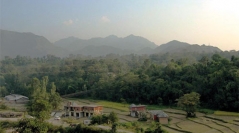

 Comptes Rendus Palevol
15 (3-4) - Pages 281-294
Comptes Rendus Palevol
15 (3-4) - Pages 281-294This paper presents the first Indo-French Prehistorical Mission in the Himalayan foothills, northwestern India, and introduces the results of the multidisciplinary research program “Siwaliks” under the patronage of Professor Yves Coppens, from the Collège de France and Académie des Sciences, France. This program is dedicated to the discovery of cut marks on mineralized bovid bones collected among vertebrate fossils in a fluviatile formation named “Quranwala zone” in the Chandigarh anticline, near the village Masol, and located just below the Gauss–Matuyama polarity reversal (2.58 Ma). Artefacts (simple choppers, flakes) have been collected in and on the colluviums. This important discovery questions the origins of the hominins which made the marks.
Siwaliks, Himalayan foothills, Late Pliocene, Indo-French Prehistorical Mission, Cut-marks, Lithic industry, Hominins